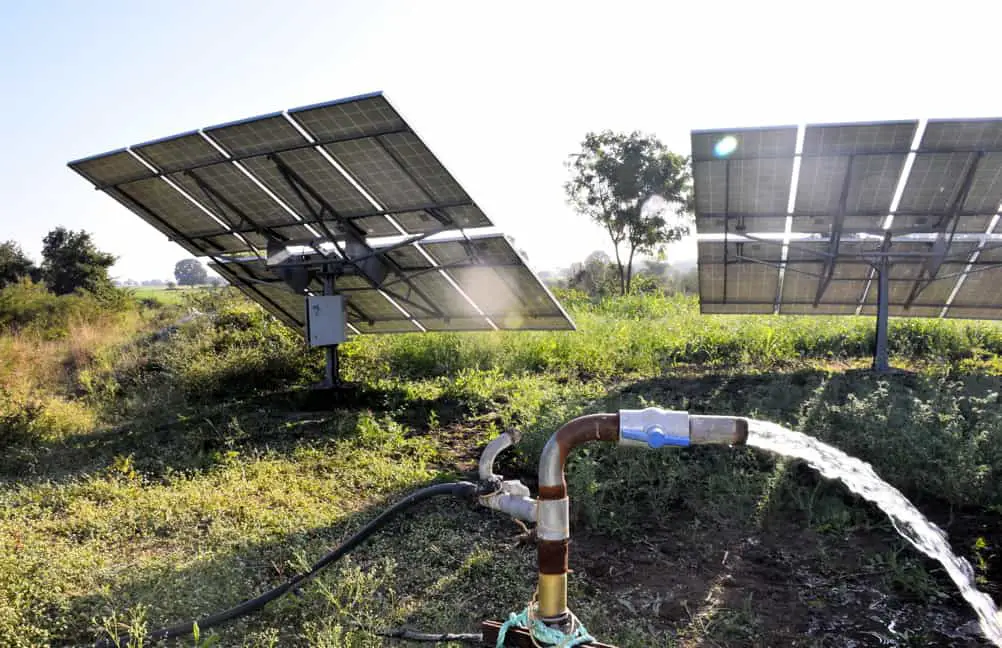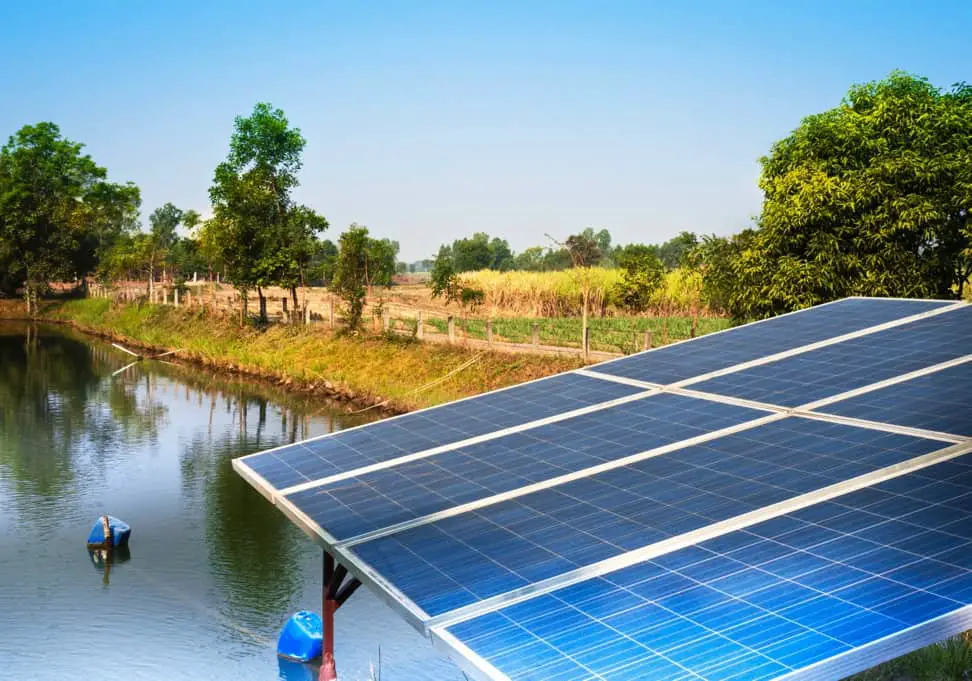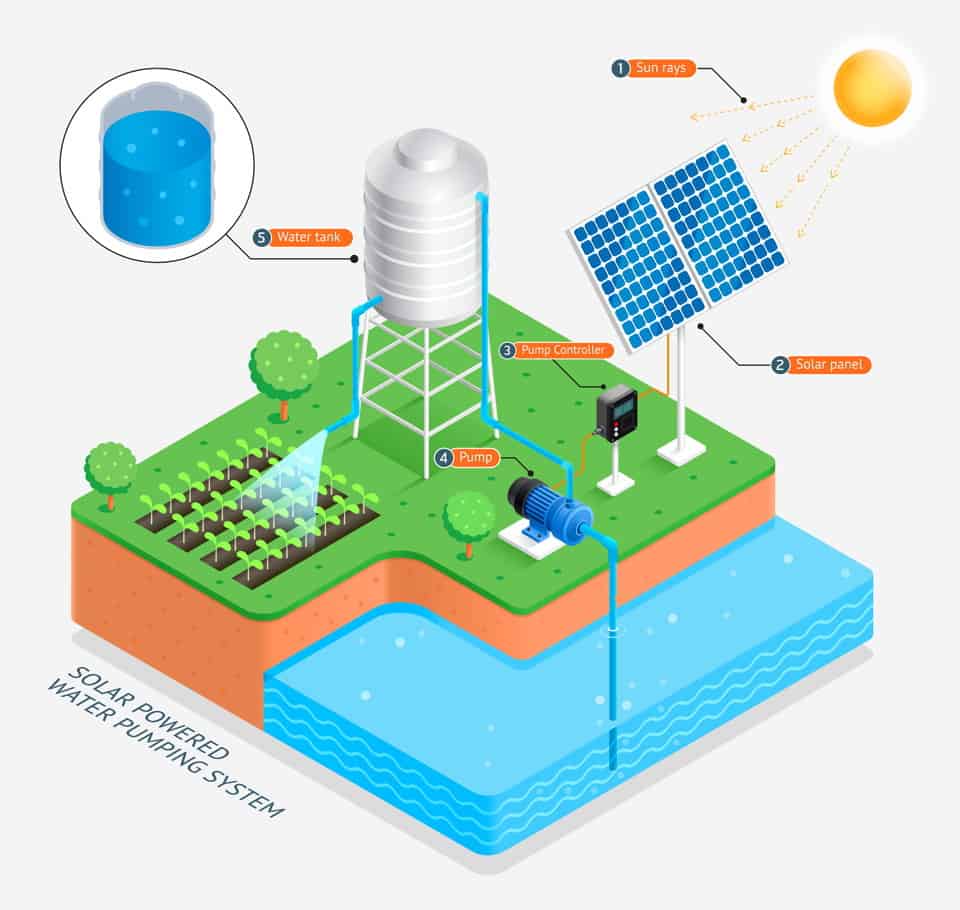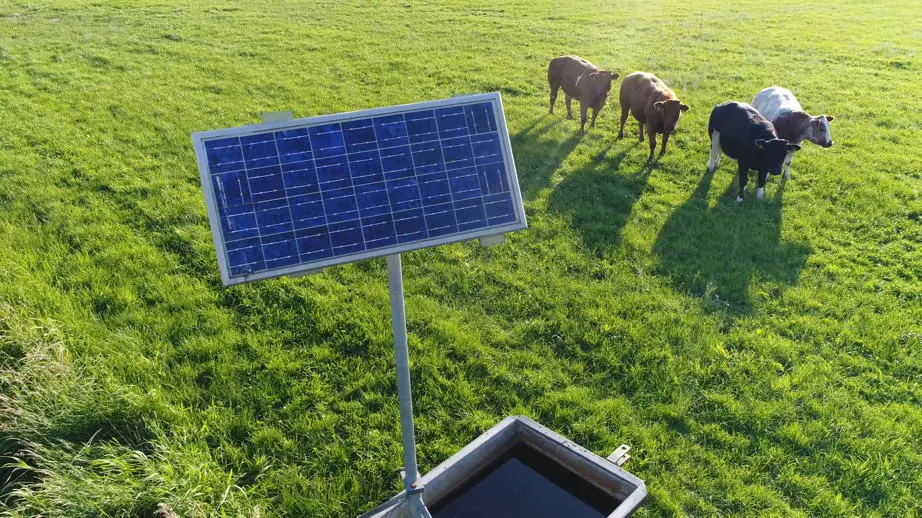
Solar pumps may solve the problem of water access where there’s no electrical grid.
Everyone knows that water is essential for people and the things that we grow. The problem, however, is that access to water resources can be limiting in settings that are far removed from municipal infrastructure. Think ranches, farms, cabins, and other off-grid dwellings.
Land users in such remote settings usually have a couple of options: use the distant power grid to run an electric-powered well pump, or use fuel-powered pumps to draw from a pond or river. Tying into the grid can cost a lot when new electrical lines must be run and then there are the recurring costs for usage.
Similarly, gasoline or diesel-powered pump setups can be pricey, require constant refueling, and can be prohibitive to maintain. And in our Leaf House Tea garden, we are all too familiar with the downsides of using gasoline pumps to move water from a pond and into our drip irrigation system.
We need a new system for watering our tea and other crops.
The Solar Pump Alternative
This is where solar-powered water pump technology comes in. Solar pumps could offer a solution to remote watering needs that is both cost effective and energy efficient. With a few simple components, solar pumping can be used in a variety of settings.
Here we discuss the merits of solar pumps, how this exciting technology operates, and the ideal situations for its application. We also compare using a solar powered pump to grid hookup for cost scenarios and look at a couple of insightful case studies.

Solar water pumps have many applications including drawing water from ponds and rivers.
Benefits of Solar Powered Pumps
So, what tips the scale towards solar pumps? In our research of the solar pump market, we have discovered that there are several features inherent to solar water pumps that can make them advantageous:
The Nuts and Bolts of Solar Powered Pumps
There are two main components to a solar-powered pump system: solar arrays for collecting energy from the sun, and the mechanical pump for moving water. To make the most of solar’s potential, it’s important to understand how solar systems function.
Solar Energy Basics
Every solar setup starts with photovoltaic cells. The cells are what produce electricity from solar radiation. Many photovoltaic cells are connected to make a panel. These panels can be connected to create a solar array. Solar panels generate direct current (D/C) as opposed to the alternating current (A/C) that is used in households. The amount of power produced by a system is dependent on the materials of the cells, the size of the panels, and the number of panels in an array.
The power from solar panels is rated in watts. A watt is a unit of power used to describe energy output or demand for electrical fixtures. You might be familiar with this concept for common household objects, say, a 60-watt incandescent lightbulb.
For solar power, watts refer to supply. Individual panels come in an assortment of wattages, anywhere from tiny 50-watt to whopping 400-watt panels. The output of each panel is not as important as the total output of all the panels used in an array. For instance, a 300-watt array can be made using three 100-watt panels, two 150-watt panels, or one 300-watt panel.
In short, the solar panels are the power supply for pumping water.

Illustration of solar panels collecting energy to run a water pump which, in turn, fills an elevated water tank.
The Water Pump
A pump is any device that uses an energy source to move fluids. In this case, it is a tool that mechanically draws water from the source and delivers it to the desired location. There are many types of pumps for just this purpose.
Certain pumps work better for solar power, in particular, those that draw less power are ideal. For deep wells, positive-displacement pumps are recommended. These pumps move a fixed amount of water with every rotation cycle, and they pump proportionally to the amount of power supplied.
Compare these to centrifugal pumps commonly used with A/C power. Centrifugal pumps draw a lot of power to pump as fast as possible. At lower power, they underperform. For instance, at half power, a centrifugal pump will pump at only a quarter of the pressure. Submersible D/C pumps, in contrast, use 20% to 50% of the energy per gallon pumped as an A/C centrifugal pump.
Energy Demand of Solar Pumps
Several factors determine the energy demands of solar water pumps. The head, or height that the water must be pulled or pushed from the water source, largely determines power need. For instance, surface water, holding tanks, or deep wells will have different demands. The distance water must travel and dimensions of water lines used are additional considerations. An obvious one is the water demand itself which is often reported in gallons per day.
An important thing to note here is that higher energy demands translate to more solar panels. More panels mean more cost and more infrastructure. Therefore, while pumps rated for solar use may be slower on average, they will produce just as much over the solar day as standard A/C pumps but at a portion of the cost.
As explained above, solar pumps are slower than A/C pumps, so it will take longer each day to meet the total gallons needed. But don’t fret because energy demands balance out at the end of the day.
Unlike A/C pumps that draw a lot of power to pump quickly and shut off, solar pumps work at the same rate that solar energy is being converted. In other words, water is pumped as long as the sun shines.
A setup like this doesn’t require batteries, and when sunshine is abundant, a solar pumping system can fill an auxiliary tank to be drawn from on days when the sun is hiding.
Solar pumping systems can be scaled to fulfill most water needs but can be limited by depth to the water source. As discussed, the energy and cost advantage of pumps for solar applications is due to lower power demand. However, this translates to lower overall strength and output. Most pumps can provide between 75 and 350 feet of lift. Although some are rated for greater depth, the increased cost of these products diminishes the benefit of solar pumping.
The Cost of Using the Electrical Grid
For sites that are not connected to the grid, the cost of stretching power lines can be substantial. According to an article by the University of Iowa, in rural parts of the US, the average rate for adding power lines beyond 1000 feet from the nearest grid-tie is $5 per foot, which totals greater than $25,000 per mile. This sum does not account for additional costs associated with reduced accessibility owing to difficult vegetation, unfavorable soil conditions, or changes in elevation.
Unless participation in a rural power co-op is an option, the landowner will eat these costs directly. Running utilities to sites more than one-quarter mile from the connection is therefore quite expensive.
After installation, there is then a regular payment for usage. Though rates for electricity differ by utility provider and by region, A/C pumps do have a higher power demand than solar pumps. This power demand will be directly consuming money in the form of utility payments. Thus, in addition to paying for a connection to service and the pumping system, there will be the recurring cost of buying energy from the grid.
The Costs of Solar Pump Technology: How Much Water per Buck?
In my research of the market, I found that a solar powered water pump for irrigation ranges from $2000 to $5000 for a solar array and pump kit, along with all connections. The kit price includes a pump for $1200 to $2500 with a balance of no more than $2 per watt for the solar panels.
The total cost largely depends on water demand in terms of flow rate, volume per day, and where it is being delivered. However, here are some examples to illustrate how water output is related to cost. The figures given here from RPS Solar Pumps are merely for demonstration purposes and not intended to as an endorsement.
According to RPS, three of their solar pump kits serve about 90% of their client’s pumping needs. From low to high range, these products represent typical costs, components, and output.
| Pump Model | RPS 200 | RPS 400 | RPS 800 |
| Number of Solar Panels | 2 x 100-Watts | 4 x 100-Watts | 8 x 100-Watts |
| Maximum Output | 1800 gallons/day | 2700 gallons/day | 3200 gallons/day |
| Output at Max Depth | 500 gallons/day at 150 feet | 400 gallons/day at 250 feet | 1,400 gallons/day at 325 feet |
| Total Cost | $2,150 | $2,550 | $3,500 |
Price and water output of three different solar powered pump kits. Data are from RPS Solar Pumps and do not represent an endorsement.
Of course, there are more expensive options, but these begin to approach the costs of the grid and alternative pumping.
Costs also depend on the water source. Surface water systems, such as those that draw from a pond or river, will tend to be cheaper due to less energy demand than water pumps submerged deep into a well.
Are Solar Pumps Competitive?
In the scenarios given above, installing solar pumps can be much cheaper than extending power lines. There are many conditions where this holds true. For any instances where electric company infrastructure must be extended more than one-quarter of a mile, solar pumps have a clear cost advantage. However, one must also consider the longevity of such projects.
A downside with many solar pump setups is that they may need to be serviced and components periodically replaced. For instance, smaller well pumps may have to be serviced every two to four years while larger well pumps and surface pumps require service about every 15 years. Most solar panels these days have life spans between 20 and 30 years.
Making sure that things are adequately installed and maintained for the intended use will offset some of these issues. Replacement of solar cells and pump components is inevitable, however.
Real-World Application of Solar Pumps
Now that we understand the basics of solar water pumps, we will look at a couple of applications that demonstrate the potential as well as the constraints of using solar systems
Case 1: Solar Pumps in Senegal
In rural Senegal where I worked as a Peace Corps Volunteer, water is the most limiting factor for vegetable productivity. Water use is also the largest consumer of time and labor for gardens where the watering is done by hand.
In this setting, tapping into the electrical grid is usually not an option, and once gardens are above a certain scale, hand drawing water is not an option either. When international aid organizations partner with these communities to build sustainable food practices, it is solar pumping systems that local farmers want.
A standard setup for a Senegalese community garden is to have a centralized well that feeds several cisterns located through the garden. Solar pumps are established to draw up water and fill the reservoir attached to the well. This reservoir then gravity feeds water to cisterns throughout the garden. From here, the gardeners fill up buckets at waist-height cisterns closest to their vegetable plot.

Community gardens in Senegal often use solar arrays to power pumps that distribute well water to centrally located cisterns.
Senegal Solar Pumps Lift Water to Towers
On private farms, solar powered pumps are used to draw water from wells and distribute to water tanks atop towers. Gravity-fed systems rely on the height of the water to provide pressure for adequate water flow.
Determining the height needed to achieve a certain water pressure is straightforward. The rule of thumb is that 2.31 feet of height at the water source is required per 1 psi of water pressure needed. Most towers are from 15 to 30 feet above the ground and from there water is gravity fed back down through irrigation piping. Most often this is directed into drip piping which usually requires about 10 and 15 psi of pressure to operate efficiently.
There is no shortage of sunlight during the vegetable-growing season in Senegal, and there is enough solar energy to supply all the water demand. With an efficient flow rate, there is less risk of drying up the well through over-pumping and drawdown. This is an example featuring the essence of solar pumping as a technology that has a big impact on productivity.
Case 2: Solar Powered Water Pumps for Iowa Cattle Ranchers
Filling livestock water reservoirs is perhaps one of the most appropriate uses for solar water pumping. Ranches with large tracts of land, far away from municipal utilities, and plenty of thirsty animals that need a reliable source of drinking water are great candidates for this technology.
In Cherokee County, Iowa, cattle rancher Dick Lester found that solar was the best solution for his watering needs on a 650-acre pasture.
Prior to installing a solar pump system, the only available water source was a small creek that ran through the pasture. With over 300 head of cattle, this riparian system was constantly being gouged away by herd traffic, and the creek’s banks left bare of grasses, were susceptible to erosion. Giving his herd multiple water sources broke the group up and resulted in more even grazing. The need to pump water was apparent, and the decision to go solar was a no-brainer in Lester’s case.

Cattle ranches are ideal for solar water pump technology.
When pricing out his pumping needs, Lester was quoted a price of $4.75 per foot, totaling $20,000, to run electricity out to his water pump. On top of that, he would be paying $30 a month on fees alone, not including the cost to run the pump. The company that installed the solar pump system estimates that a full setup for ranchers is usually between $5,000 and $7,000 including installation. Factor in the fact that many regional Natural Resources Conservation Service programs offer up to 75% cost-share for solar pump installation and there is nothing that comes close to being as effective and affordable.
Lester’s system uses a solar array of eight 175-watt panels. These panels power a pump that draws water from the creek and delivers it through 4600 feet of pipe and up to 150 feet to fill three large tanks. The watering system uses fill valves to signal the pump on and off based on the water level in the tanks.
This is a great example of how solar power can be used to supply water on demand. Also, by storing plenty of water in the tanks, there is no need to have batteries for times when there is a lack of solar power.
Systems like this one have picked up a lot of traction at ranches across the US. With cost-share programs like those offered by the NRCS and other rural resource organizations, this is the best deal for livestock watering.
Well Digging: the Hidden Cost of Solar Water Pumps?
As previously mentioned, solar pumps come in two main categories: surface and submersible. Surface pumps are straightforward. In any body of water, these pumps can deliver sufficient flow rates (between 4 and 10 gallons per minute on average) without drawing much power. In addition to natural water bodies, this is a good option for cisterns and other water catchments.
For deep wells, submersible pumps are required. Submersible solar pumps have come a long way in design options, and chances are that there is a pump design out there that fits your needs. The questions are, how deep into the earth do you need to go and how much water do you need? What is true for all wells is true for solar pump wells. The deeper it goes, the more it costs. Submersible pumps designed for solar power are built to be more energetically conservative so that the supply of power coming from the panels can maintain the pumping load.
As previously noted, however, there is a limit to the vertical height that a solar powered pump can move water. The maximum lift for most pumps is between 75 and 350 feet, and though some can go deeper, the increased requirement on design brings the pump prices up and the cost-savings down.
In most applications, it will not be necessary to sink wells any deeper than the upper edge of the water table. Safety concerns for domestic water use aren’t necessary for plants and livestock, so shallow wells are usually sufficient. The lower flow rate of these pumps complements shallow and slow-restore wells.
Conclusion
Solar water pumps are energy efficient solutions for many off-grid watering applications. The technology is suited for a range of water needs but is optimized for systems with low flow. Solar pumps are also well suited for areas where other power sources are either unavailable or too costly to access. The most relevant applications include irrigation, livestock drinking water, and reservoir regulation in ponds and lakes.
Solar powered pumps are useful for supplying gravity-fed systems and distributing stored water. Pumps can be used in surface water or groundwater sources.
The biggest trade-offs are in power and unit lifespan. Solar pumps sacrifice lift power for pumping efficiency, and there are limits to the rate at which solar energy can be converted to electricity even under peak solar intensity. For very deep water or high flow rate requirements, solar water pumps are no longer economically competitive. Even if functional, using the systems closer to their upward limit puts undue strain on the pump components, which only hastens the need to service or replace the system.
Regardless of the power load, the solar array and pump will need regular attention and will need to be periodically upgraded.
Although the longevity of such systems may be limited, there are plenty of practical, cost effective applications to justify the investment. As interest in solar pumping systems increase, improvements on existing systems and design of new enhanced operations will advance this technology further.
 简体中文
简体中文  English
English